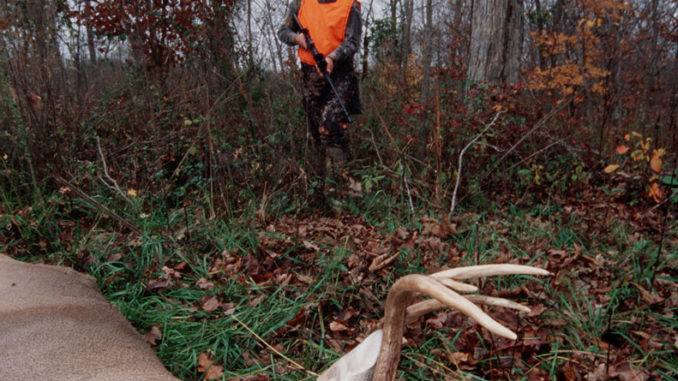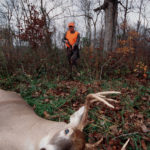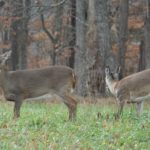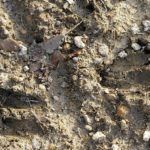
Hunt long enough in places that bucks are using and you’re likely to catch one with its guard down.
If North Carolina hunters could change a season by picking a month to extend longer than usual, it’d be November and deer season.
Many hunters would like November’s typical cool mornings and evenings to begin in early September and extend through December. That kind of weather and the dwindling amount of daylight would keep whitetail bucks in a moving frenzy, and when it comes to bagging a big buck, nothing would tip the scales in favor of a hunter more than a longer breeding season. Of course, this isn’t a real scenario.
However, realistic tactics and ideas are out there to help get a trophy within range, including: elbow grease, a few supplies, equipment and some land.
Ron Nixon of Orange County used all four to lure a magnificent 10-point, 164 4/8 inches non-typical in front of his tree stand last Nov. 16.
Nixon, 27, tended food plots last summer at a 150-acre former tobacco farm owned by his brother-in-law. Nixon’s fiancée, Kierra Payne, a raven-haired beauty from Missouri, helped him get the land ready for the 2013 hunting season — and she bagged a nice 10-pointer.
“We planted small plots, 1/4- to 1/2-acre, inside hardwood stands,” he said. “But they were big enough so sunlight could get to the clover we planted.”
They used a small garden tractor to till the soil and spread fertilizer, while a seed-spreader scattered clover and other seed mixtures. The property was also close to a known bedding area, with oaks nearby, and some row crops, including corn, planted on the property and in neighboring gardens.
Moreover, the property shared a common border with what Nixon calls a “camp” where no hunting was permitted. Happily also, his deer honey hole wasn’t easily accessible to unwanted vehicles.
“Deer don’t get pressured in there a lot,” said Nixon, who also knew he had only a few short weeks at November’s start, extending about two weeks after the peak or the rut, to take advantage of cruising bucks looking for lady loves.
Biologists insist the breeding season lasts longer than a few days — and that theory is technically correct, because surveys show some does mate as early as August and as late as December. But the “peak” of North Carolina’s rut hits in early November. Evin Stanford, the N.C. Wildlife Commission’s top deer biologist, said the peak of the rut in coastal counties will be around Nov. 2, with Nov. 15 being the big day in Piedmont counties.
Dedicated hunters know the two weeks just before and after the rut’s high point are the best times to be in the woods, because that’s when bucks roam constantly.
Hunters who think the peak of the rut is the best time to hunt trophy deer are mistaken. At the apex of the mating season, dominant bucks suddenly stop chasing does. By then, they’ll have beaten off rival suitors and corralled one, two or three “hot” female deer. They’ll remain with the ladies, perhaps holed up in a thicket or swamp, as long as the does are receptive.
However, the two weeks before and after the rut peaks provide hunters with their best chance of harvesting a trophy buck or even a doe. That’s also why it’s not unusual to hear of novice hunters killing huge bucks.
With deer in hyper-drive during before and after the peak of the rut, many hunters do at least one right thing — watching and waiting near places deer are using — and that often gives them as good a chance as an expert to drop a wall-hanger trailing a doe.
Rutting bucks often are so intent on sniffing out a specific doe, they’ll ignore obvious dangers — including walking across busy highways or appearing in suburban yards. And that means more than a few big bucks walk within range of hunters of all ages and abilities who are carrying muzzleloaders, rifles or shotguns.
Bucks in the grip of the mating urge also will visit places they’d never been before. Hunters who shoot male deer with rocking-chair headgear commonly talk about never having seen that particular animal until it walked in front of their stand.
Unfortunately, this time is fleeting. It’ll be a long 11 1/2-month wait until deer craziness happens again.
Nixon related how hunting the rut helped him and his fiancée last year.
“I’ve been hunting my brother-in-law’s farm for my whole life, probably 16 years, and I never saw a buck like this until last year,” he said. “I don’t put up trail cameras, but a 15-year-old killed a different deer close to my brother-in-law’s farm three years ago, and it scored in the high 140s, plus, the rack had a broken-off G2. If that tine hadn’t been broken, it probably would have scored in the high 150s or 160s.
The boy killed that buck right on other side of the camp land, and we saw pictures of it (the property owner) had gotten off his Cam Trackers.”
Nixon and his fiancée did put out corn at one spot at the farm, but not near their stands, which is unusual in a state that allows baiting of deer.
“We do (use) corn, but we don’t put it near our stands,” said Nixon, who said it’s been his experience that big bucks rarely die during daylight hours near corn piles.
“My nephew also hunts the property, and he puts some corn out, but only to see what type of deer are in the area,” he said. “Most of the pictures he gets on his trail cameras are taken at night.”
The morning Nixon killed his deer was overcast and in the 60s; he was sitting in a portable tree stand about 25 feet off the ground at the edge of a food plot. He had gotten an early start, walking in in the darkness and climbing into his stand at 5:30.
“I never use a flashlight to go to a stand,” he said. “I know the way to my tree stands. After my eyes adjust to the dark, it’s not hard to see. I think a flashlight spooks deer, and they won’t come back to a place once a moving light in he woods gets them nervous. It’s not a normal thing for them to see, lights moving through woods just before dawn, and they remember it.
“I did spook some deer going in without a light, but I think deer are used to noises in the woods at night. But if they see a flashlight, they’ll be long gone that day, especially a buck.”
One advantage provided by Mother Nature was rain that had dampened the fallen leaves and allowed Nixon to walk nearly noiselessly.
Also unlike most hunters in the Piedmont, Nixon eschews a rifle for a shotgun, a 12-gauge Benelli autoloader that handles 3 1/2-inch shells filled with 00 buckshot.
“During the rut, you’re likely to see a lot of runnin’ deer,” he said. “Where our stands are, there’s a lot of standing timber, so a rifle’s not a really good gun to have. A shotgun is ideal. If you’re using buckshot, it’s very effective at short ranges.
“If I’m at a big bean field or something like that, I’ll use my rifle, but for where I hunt in Orange County, a shotgun is a better choice.”
After Nixon settled back in the stand and the woods quieted, deer soon began to appear, but it was so dark, the hunter couldn’t get a clear view of what was making hoof falls he heard. Then just as the world began to take shape, “I heard a commotion coming from on my left,” Nixon said, “but I still couldn’t see what it was.”
He finally caught movement and saw a doe hop into the clover field and “(the big buck) came right behind her. It wasn’t totally light, and when I looked at the food plot I saw his white antlers,” Nixon said. “But he was chasing and quartering away from me to the left.
“I thought he wasn’t going to stop or come back, so I decided to take the shot.”
The buck was around 40 yards from Nixon when he pulled the Benelli’s trigger. However, the buck showed almost no ill effects.
“He put it in high gear, but his tail was tucked, so I felt like I’d hit him,” Nixon said.
After a few minutes, he called his nephew, Dustin Elmore, and asked him to meet him on the farm’s dirt-road entrance. Then, he climbed down to begin a search for the buck.
“He didn’t run far, maybe 50 yards to the edge of the field and another 40 or 50 yards into the woods,” said Nixon, who found his buck of a lifetime piled up on the side of a small hill.
The 10-pointer carried main beams that measured 22 7/8 and 23 1/8 inches, a 20 1/2-inch inside spread and a 6 7/8-inch drop tine on the right beam.
“I’m pretty sure he’d have scored higher, but I think a buckshot pellet is what knocked off the tip of his right main beam,” Nixon said. “The pellet went through the G2 and knocked off a chunk off it then hit the main beam.”
Hunting during the rut obviously worked for Nixon and could work for anyone. When November bucks lose their minds, it’s not a bad idea for hunters to go a little crazy about hunting the rut.







Be the first to comment